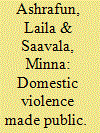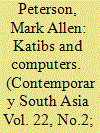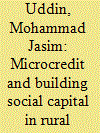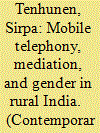|
|
|
Sort Order |
|
|
|
Items / Page
|
|
|
|
|
|
|
| Srl | Item |
| 1 |
ID:
130732


|
|
|
|
|
| Publication |
2014.
|
| Summary/Abstract |
Disputes within the family and cases of domestic violence in Bangladesh have traditionally been resolved either among kinsmen or in village panchayats where young women have had less opportunity to be heard. This article describes a third-sector initiative in alternative dispute resolution (ADR) in cases of domestic violence in Sylhet, Bangladesh. Data from 20 case studies of female victims of domestic violence, interviews with six lawyers, and participant observation in 10 mediations in a counselling centre are used to examine how this kind of social innovation affects the bargaining position of battered women in a kin-based, patrilineal and patrilocal society. The battered women involved in these mediations were rural or urban, less educated, and economically disadvantaged. The findings illustrate the limitations of ADR in cases of domestic violence. ADR as practiced in Sylhet, Bangladesh provides poor women a chance to be publicly heard in mediations of their domestic crises. However, ADR often fails to deliver lasting, just, and socially progressive solutions. The adoption of ADR practices should not be considered as an alternative to the development of the formal judicial system, because it lacks the power to enforce agreements and supports the hegemonic status quo, leaving the battered woman and her natal family with very limited options.
|
|
|
|
|
|
|
|
|
|
|
|
|
|
|
|
| 2 |
ID:
130727


|
|
|
|
|
| Publication |
2014.
|
| Summary/Abstract |
This special issue examines innovation as social change in South Asia. From an anthropological micro perspective, innovation is moulded by social systems of value and hierarchy and simultaneously potentially transforms them. The articles in this special issue examine a number of innovations in South Asian contexts: the printing press's changing technology and its intersections with communal and language ideologies in India (Peterson); mobile telephony, gender, and kinship in West Bengal (Tenhunen); microcredit and its relationship with social capital in Bangladesh (Uddin); imbalanced sex ratios and the future of marriage payments in north-western India (Jeffery); and how alternative dispute resolution as a social innovation affects battered young wives' life situation options in Sylhet, Bangladesh (Ashrafun and Säävälä). These case studies give insights into how the deeply engrained cultural models and values affect the forms that an innovation process can take. In a social field, actors are not situated symmetrically vis-à-vis an innovation. In South Asian societies that are starkly hierarchical and holistic, innovations may have unpredictable sociocultural repercussions.
|
|
|
|
|
|
|
|
|
|
|
|
|
|
|
|
| 3 |
ID:
130728


|
|
|
|
|
| Publication |
2014.
|
| Summary/Abstract |
In 1993, the prognosis for Urdu newspapers in north India was dismal. The readership was aging and dwindling as the new generation learned Hindi in Devanagiri script. Urdu calligraphers (katibs) were not passing their skills on to a new generation and writers skilled in Urdu were becoming increasingly hard to find. Fifteen years later, Delhi is home to a prosperous and expanding Urdu press. The number of newspapers had tripled, circulations were often higher than they had been in the past, profits were up and the atmosphere at Delhi's major Urdu newspapers was upbeat. A large part of the explanation lies in the intersection of language ideologies and new writing technologies. On the one hand, Urdu indexes crucial politically urgent populations, leading to a renewed interest in it from many sectors. On the other hand, new more flexible technologies allowed the retiring katibs to be replaced by computer typesetting that strongly resembles north Indian calligraphic styles and new software allows an entire daily newspaper to be assembled and sent to press using a single laptop. Drawing on ethnographic fieldwork in 1993 and 2008 at some of New Delhi's Urdu dailies and interviews with several editors, this article describes the mutual influences of Urdu language ideologies about Muslim identity and technological innovation in the revival of the Urdu daily.
|
|
|
|
|
|
|
|
|
|
|
|
|
|
|
|
| 4 |
ID:
130729


|
|
|
|
|
| Publication |
2014.
|
| Summary/Abstract |
In the 1990s, social capital and the group-based microcredit programme emerged as major planks of developmental interventions, and both approaches have underscored the necessity to mobilize social factors in the alleviation of poverty and social solidarity. The group-based microcredit model is considered an effective policy instrument for increasing women's access to financial capital and for strengthening their social capital at the local level. This study contributes to the continuing debate over how or if group-based microcredit facilitates to the formation of social capital at the local level in Bangladesh. Case studies and ethnographic (in-depth) interviews of 151 women microcredit borrowers of the Grameen Bank and the Bangladesh Rural Advancement Committee of Bangladesh were used in this study. The study suggests that the relationship between participation in the group-based microcredit programme and the facilitation of social capital at the local level is at best ambiguous. The assumed association between microcredit membership and building social capital (social networks, norms of reciprocity and collective identity and action) is much less prominent than commonly suggested by many previous scholars and development practitioners.
|
|
|
|
|
|
|
|
|
|
|
|
|
|
|
|
| 5 |
ID:
130730


|
|
|
|
|
| Publication |
2014.
|
| Summary/Abstract |
This article aims to develop the understanding of new media and social change by examining how mobile phones mediate kinship and gender in rural India. I provide a nuanced picture of the contested nature of kinship and gender in the village based on long-term fieldwork in order to explore how mobile phones mediate relationships and ongoing processes of social change. The article illustrates how the physical qualities of phones help strengthen the multiplicity of discourses by mediating relationships and contributing to the multiplicity of speech contexts. Mobile phone use has been encouraged and motivated by kinship relationships and the use of mobile phones has, in turn, transformed these relationships by helping to create new contexts for speech and action. However, instead of the drastic improvements or changes, for instance in economic power relationships, the positive impacts of women's phone use appear subtle and ambiguous: most calls are about the slight redefinition of the home boundaries.
|
|
|
|
|
|
|
|
|
|
|
|
|
|
|
|
| 6 |
ID:
130731


|
|
|
|
|
| Publication |
2014.
|
| Summary/Abstract |
The gendered character of India's fertility decline has attracted considerable academic attention. In this paper, I offer a critique of the arguments of some demographers about the linkages between dowry, daughter aversion and the marriage squeeze that predict that increasing shortages of marriageable women will result in declines in dowry. I argue that such economistic readings seriously oversimplify the complexities of marriage arrangement 'on the ground' in contemporary India. Further, whilst one aspect of dowry might relate to the supply and demand of brides and grooms, dowry and daughter aversion are not simply outcomes of demographics alone. First, marriage migration is crucial in understanding daughter aversion. Second, dowry is not just a matter of marriage and kinship practices. Dowry is a polyvalent institution that also connects with conspicuous display in status competition in a hierarchical society and with people's rising aspirations to possess consumer goods within the wider context of contemporary India's rapidly changing political economy. Crucially, marriage migration, status competition and consumerism do not necessarily push in the same direction as the demographics of the marriage squeeze might imply when it comes to dowry and daughter aversion.
|
|
|
|
|
|
|
|
|
|
|
|
|
|
|
|
|
|
|
|
|